Mon 13 Sep 2010
It’s How You Frame It
Posted by anaglyph under Art, Travel
[28] Comments
Last Monday was a public holiday in the US of A so I got that rarest of things on a Hollywood film schedule – a day off. To celebrate, I decided that I would make my way to the Museum of Contemporary Art in downtown LA and catch myself a little kulture. I have to confess: I am a little at sea with modern art. Some of it I think is beautiful and moving, but there are vasts rafts of it that to me just look like pretentious crap. I don’t know how you are supposed to tell the difference.
MOCA is currently showing a retrospective of an artist named Arshile Gorky whose work just seems to my eye like a semi-competent blend of Matisse, Miro and Tanguy, with none of the originality of any of those great painters. I am probably showing my colours as a Philistine of outstanding magnitude by saying that, but since I shoot my mouth off about everything else here on The Cow, why stop now? Here’s a Gorky that’s like something by Joan Miró painted (but never finished) by a blindfolded and inebriated Yves Tanguy:
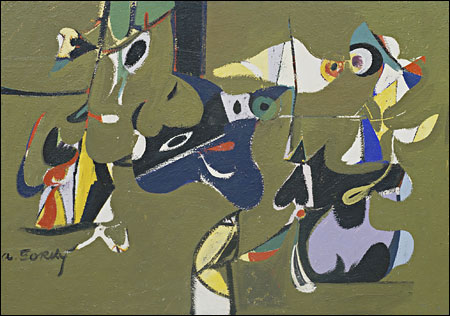
It was probably undignified of me, but as I walked around the exhibition, I kept having the thought that Americans only embraced Gorky because they were jealous that they didn’t have any of the aforementioned European painters. ((The fact that he had a miserable life and then an untimely and unpleasant death probably added to the cachet.)) I know that there is a lot of borrowing and re-borrowing in the art world, but this particular instance seems so close to plain plagiarism that it baffles me that Gorky has the reputation he has.
Wandering onward through the nicely laid-out MOCA galleries I was further perplexed by the work of Craig Kauffman – plexiglass creations in bright colours with attached artist statements that were as nonsensical as anything ever written by Edward Lear.
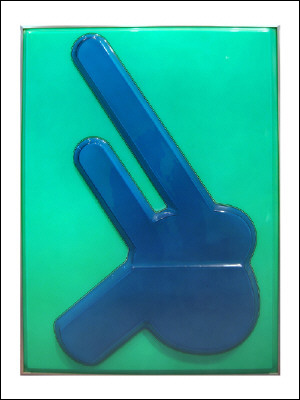
Reading the little cards next to each work, I had the overwhelming impression that Kauffman was pulling everybody’s legs. Which is not to say that he hasn’t actually made some good works, ((I have seen some Kauffman that I quite liked, but MOCA doesn’t have any of those ones.)) but rather (as is, in my experience often the case) that his justification for creating them seems predicated on convincing less intellectually-inclined people that he is doing something profound by using elliptical language and vague philosophical pontifications. Art waffle-speak is as abundant as political waffle-speak, and that’s saying something. I have yet to see an artist statement that says something along the lines of ‘Oh, I dunno – I just started painting something and this is how it came out…’ God forbid that an artist might be proceeding purely along the lines of intuition. ((The reason for this is plain to me – if you want someone to buy your work, then the pressure is on to convince them that its genesis is something more than just your artistic muse speaking to you in incomprehensible-to-the-common-person muse language.))
Perhaps the work I liked the very least came from James Rosenquist:
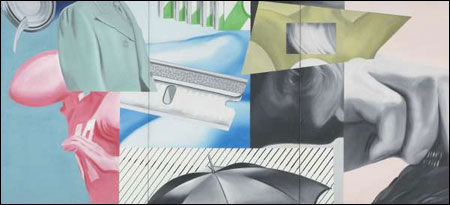
Now I suppose there are many and varied reasons why this artist is considered worthy of being displayed in one of the premier art institutions of the USA, but frankly, buggered if I can see ’em. To me, this work, and most of the other Rosenquists on display just look like the kind of thing that a lazy high school art student with little talent would whip up the day before it was due for marking. I mean… can anyone explain to me what’s good about this? Anyone?
It has none of the majesty and gravitas of Mark Rothko:

…or the passion and power of Jackson Pollock:
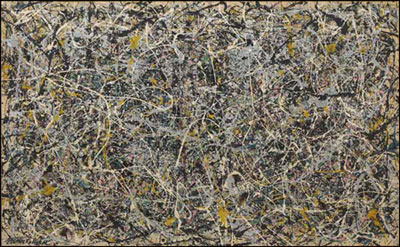
…or even the wit and elegance of some of the lesser known artists also on display, like Antoni TÃ pies:
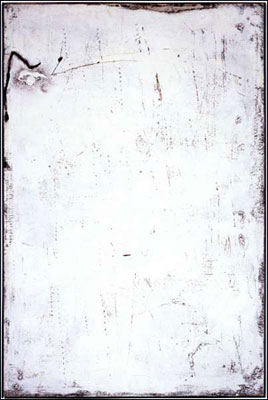
…or Louise Nevelson:
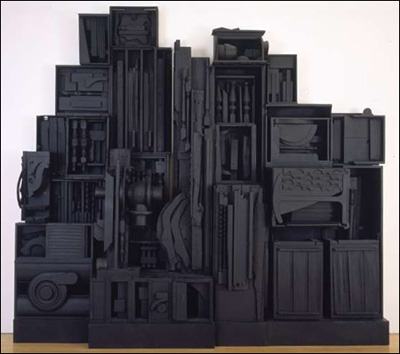
…or Kenneth Price:

…whose works all show imagination and thought and originality and … well… skill. ((One thing I noticed when making this post was that rendering all these works to small jpegs has a weird consequence: the ones I disliked in the gallery are improved by the process, and the ones I liked don’t seem quite as impressive. It is truly a case of ‘you had to be there!’)) The thing I enjoyed most in the museum was its sizeable collection of the photographic works of Robert Frank. I have, of course, seen Frank’s work before, but seeing them here, in America, so beautifully presented, made them very moving indeed. My favourite work at MOCA? This Robert Frank portrait of a Jehovah’s Witness (it’s a bit hard to tell in this small jpeg, but the key to this image is the ‘Awake’ magazine that the man is holding):
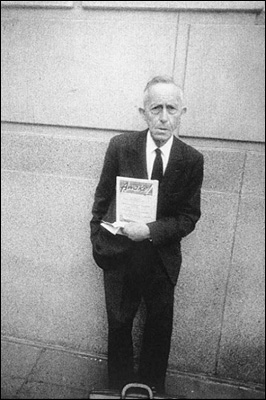




I like your point about art waffle speak. I have to teach art secondary students and its difficult enough for me to translate the stuff that goes up on gallery walls as ‘explanation’ of the works, let alone the kids. And if I hear one more artist talking about their ‘practice’ I will scream… Perhaps the whole grants application process (in Australia at least) is part of the problem.
I’m sure that many artists have intentions and messages with their work, but I’m equally sure that many don’t really understand why it is that they do what they do. Unfortunately it’s hard to get a grant based on ‘I paint what I like…’
:-)
There is, however, a point beyond which those artists statements have NO meaning whatsoever. A few of them I stood there reading and silently saying to myself ‘What? What? What?’
I will show you when we go?
I once had the pleasure of being in a room full of Rothkos when the Philips Collection came to Oz. I felt moved to tears of wonder.
A photograph just doesn’t convey their beauty. It’s such a pity that it’s hard to see great art in person (so to speak). We can attend great operas, see great films and read great books – all with the full experience simultaneously around the world.
I wonder how the availability of viewing art affects our attitudes to it? If a teenager can see Apocalypse Now on Saturday night, but only ever see a Rothko or a Pollock in a book, how can they really know what it’s all about?
True. Some things become iconic because of their sheer physical presence – that is certainly true of Rothko and Pollock. But it’s not physical presence alone. The Rosenquists take up entire walls, but that just serves to accentuate their terribleness in my book…
I think even a 10 inch Rothko would be exquisite
I love Tapies myself
He doesn’t do elephants, as far as I’m aware.
If there’s one thing that makes me want to run screaming, it’s artists’ statements.
Never read them!
Actually, I do occasionally, but only if the work speaks for itself and if I know the artist isn’t too much of a tosser…
A room full of Rothkos – how wonderful
A colleague once told me he was in a room full of Rothkos in the US when word whispered around the gallery that Diana had died. He said he stood with a group of strangers, all crying silently, staring at the paintings. Rothko and Diana are always linked in my mind.
I am always amused by works entitled Untitled (Something In Brackets). Because clearly the title of the work is Something In Brackets.
Oh, I didn’t know Rothko suicided. Sad.
>>Apparently the artist in question placed the three billiard balls on the table, that was all.
I’m still trying to get a job like that. I reckon I could do it pretty well.
That Kauffman piece doesn’t happen to be on loan from a “museam” in St. Petersburg, does it?
If you hang a piece of cheesecloth in front of it, you might be able to call it art…
Hope you and VT are having fun removing the cheesecloth!
The King
.
hee hee
I prefer J. Polack to J. Pollock.
Guess who else is in LA? Your old buddy Popoff! http://joemygod.blogspot.com/2010/09/televangelist-scammer-peter-popoff-is.html
I haven’t heard from him in a while. Maybe I should look him up while I’m here. I’m sure he’d be entertaining.
I might be going on Saturday. Now I’ll just head for the Rothkos.
I fail to understand why exactly you need someone to explain the value of a Rosenquist to you, but I will try anyway. I happen to love Rosenquist. This particular one is not one of his best works, but that is neither here nor there… regardless of whether or not you like Rosenquist, to say that he lacks skill is simply absurd. His technique is phenomenal. His best works, I will admit, are more compositionally balanced and provocatively colored than this one (see, for instance, “House of Fire,” my favorite Rosenquist painting which I have visited numerous times at the Metropolitan Museum of Art).
Rothko’s work, on the other hand, can be vaguely attractive (often not even that), and his methodology is somewhat interesting, but I tend to place a higher value on work that both packs and immediate punch and invites prolonged examination. A Rothko, well, it deserves a glance in passing I suppose.
Well, each to his own, Yael – that’s the core of the artistic experience I suppose. I agree with you that ‘House of Fire’ is a more engaging work than anything I saw in MOCA, but I profoundly dislike the piece I showed above. Rosenquist has said:
Which, to me, begs the answer – ‘I don’t. Please don’t brandish that thing in my face.’ This kind of ‘shock jock’ art is something I find brash and unappealing. And cheap. This would be the ‘immediate punch’ that you’re talking about I suppose. Me? I prefer something with a little more elegance.
But hey, it’s only an opinion. That you can think that a Rothko ‘only deserves a glance in passing’ says to me that you’re missing the same thing in Rothko that I’m apparently missing in Rosenquist.